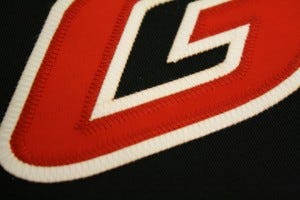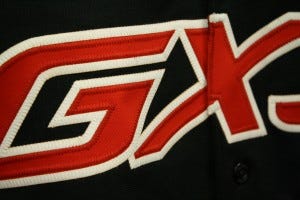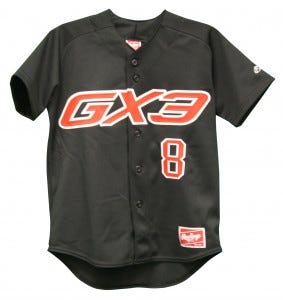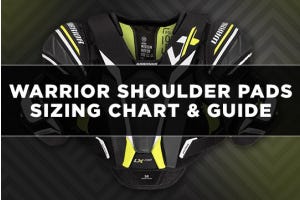What is Tackle Twill in Hockey?

Tackle twill, a time-tested embellishment technique, adds a touch of classic elegance and enduring character to apparel. With its roots in American football uniforms, tackle twill has transcended sports, finding its way onto letterman jackets, corporate wear, and yes, even hockey jerseys. But what exactly is tackle twill, and why is it a popular choice for hockey apparel? This comprehensive guide delves into the world of tackle twill, exploring its materials, applications, and unique role in the world of hockey.
Defining Tackle Twill and Its Applications
Tackle twill, also known as applique, is a method of decorating fabric with pre-cut shapes, typically letters or logos, made from a durable twill fabric. These pre-cut shapes are then sewn or heat-pressed onto the garment, creating a raised, textured effect. Beyond the iconic lettering on football jerseys, tackle twill finds uses in various applications:
- Letterman Jackets: Tackle twill is a mainstay for crafting varsity letterman jackets, adorning them with bold letters and emblems that represent achievements.
- Corporate Uniforms: Companies often utilize tackle twill for their uniforms, adding logos and employee names for a professional and polished look.
- Promotional Items: Hats, bags, and other promotional items can be embellished with tackle twill for a touch of brand recognition and a classic feel.



Exploring Tackle Twill Materials and Techniques
The magic of tackle twill lies in its simple yet effective combination of materials and techniques:
- Durable Twill Fabric: Tackle twill lettering and logos are typically cut from high-quality polyester twill, known for its strength and ability to resist fading.
- Adhesive Backing: Many tackle twill pieces come with a heat-activated adhesive backing, allowing for quick and easy application using a heat press.
- Sewn Applications: Traditionally, tackle twill was sewn onto garments for a more secure and permanent bond. This method is still used for detailed applications or thicker twill materials.
Crafting with Tackle Twill Lettering
Adding tackle twill lettering to your own garment is a fun and rewarding project. Here's what you'll need and how to do it:
- Gather your tools: Scissors, heat press (optional), iron (if no heat press), fabric of your choice, pre-cut tackle twill letters, and a pressing cloth (optional).
- Layout your design: Arrange the tackle twill letters on your fabric to ensure proper placement.
- Heat press application (if using): Follow the instructions for your heat press to apply the tackle twill with heat and pressure.
- Iron application (alternative): Place a pressing cloth over the tackle twill and use your iron on a high heat setting (refer to twill care instructions) to activate the adhesive backing and secure the letters.
- Sewn application (optional): Using a needle and thread that matches your tackle twill, sew around the edges of the letters for a more permanent bond.
Tackle Twill vs Embroidery
While both tackle twill and embroidery are popular methods for embellishing garments, they offer distinct advantages:
- Technique: Tackle twill utilizes pre-cut shapes, while embroidery involves stitching a design directly onto the fabric.
- Durability: Tackle twill is generally considered more durable, withstanding washing and wear and tear exceptionally well. Embroidery can be just as durable, but the thread can snag or fray over time.
- Appearance: Tackle twill offers a raised, textured look, while embroidery creates a smoother, more integrated design.
Tackle Twill in Hockey Apparel
Tackle twill plays a significant role in hockey apparel for several reasons:
- Unmatched Durability: Hockey jerseys endure a lot of physical stress. Tackle twill's robust construction ensures the lettering, numbers, and logos withstand the rigors of the game without cracking, peeling, or fading.
- Bold and Eye-Catching: The raised texture and vibrant colors of tackle twill lettering create a visually striking presence, making it ideal for showcasing player names, numbers, and team logos on jerseys.
- Professional Look: Tackle twill adds a touch of sophistication and tradition to hockey jerseys, contributing to the overall professional and polished appearance of players and teams.
While other decoration methods exist, tackle twill offers a unique combination of durability, visual impact, and a timeless aesthetic, making it a preferred choice for many hockey jerseys.
FAQs on Tackle Twill
How do you care for tackle twill garments to ensure longevity?
Follow the care instructions on the garment label. Generally, washing inside-out on a gentle cycle and using mild detergent will help preserve the tackle twill applications.
What type of fabric is best suited for tackle twill applications?
Tackle twill adheres well to most woven fabrics, including cotton, twill, and synthetic blends. Avoid delicate fabrics that might not withstand the heat application.
Can tackle twill be used for non-apparel items?
Absolutely! Tackle twill can be applied to various non-apparel items like tote bags, hats, phone cases, and even coasters.
What are the cost implications of choosing tackle twill over other decoration methods?
The cost of tackle twill can vary depending on the complexity of the design, size of the lettering, and material quality. Compared to embroidery, tackle twill can be a more cost-effective option for simpler designs, especially for larger quantities.
How does tackle twill impact the weight and comfort of sports uniforms?
Tackle twill adds minimal weight to garments compared to other embellishment methods like heavy embroidery. The lightweight twill fabric ensures comfort and breathability for athletes during games.









Login and Registration Form
or
Create an account